A brief history of my personal relationship with hip-hop.
Almost a decade ago, I was overweight, useless at sports, and seemingly a rocket scientist to the other kids – partially owed to the fact I wore thin, out-of-fashion glasses. I felt like I had been crafted as the textbook-perfect nerd for the common childhood tyrant to pick on. I remember specifically thinking to myself, “I have to be cool,” and the first thing that was deemed ‘cool in skool’ was ‘Hip-Hop’.
Nobody at the age of twelve really cared about how the prolific gang called “Ghetto Brothers” marched onto a street corner and connected their guitars and amps to the lampposts in South Bronx and protested racial discrimination in New York with their block parties. Nobody thought it mattered that Hip-Hop was a socio-political culture. The only thing that everybody cared about was that it sounded good. It took a great friend of mine to teach me how to appreciate Hip-Hop aurally and (perhaps more importantly) contextually.

At the end of the 1960’s Civil Rights Movement, black families from the ghetto were still struggling with racial segregation, increased economic oppression, individualised hate crime and disenfranchisement. Specifically with the inferiority of the “coloured” education standards due to underfunding as well as the many psychologically frail fathers returning from the Vietnam War (the result of PTSD or significant impairment from the teratogen, Agent Orange).
Despite children finding “surrogate parenting” by joining gangs and criminal groups, the contagiously fun rhythm and rhyme became the obsession of a generation and conscientious hip-hop was born, challenging the economic and political conditions of the period. Funnily enough, a city-wide blackout in 1977 resulted in an extensive looting spree in the Bronx, especially of deejay equipment which inevitably helped to spread the culture to other impoverished communities. Perhaps somewhat illegally, this was the start of hip-hop.

This new exotic genre of music and dance began to garner attention. Latino youth who were also living in poverty started to join the culture. It was pandemic and eventually reached other parts of America. Detroit-born James Dewitt Yancey (better known as Jay Dee or J Dilla), was impacted by the Hip-Hop movement and locked himself in the basement (voluntarily) with a set of cheap turntables and his parent’s collection of 45” vinyls with soul, jazz, and RnB. Though he wasn’t part of the Bronx or a gang, he became one of the most influential Hip-Hop artists of all time, particularly famous for his elaborate production styles. His compositions of blaringly repetitive, sometimes dissonant, and always funky brass instrumentation coupled with strong backbeat percussion rhythms à la Pete Rock contrasted with his passionate deep neo-soul sampling and silky smooth multi-vocal arrangements. Artists such as Janet Jackson, Common, De La Soul and literally hundreds of other hip-hop, and R’n’B musicians have collaborated with the Detroit-born genius who has created countless albums, mix-tapes, and drafts. He is perhaps most famous for his Donuts album, released on his 32nd birthday, just three days before his battle with the incurable Moschcowitz disease ended in his passing. After his untimely death, his unfinished album The Shining, featuring artists such as D’Angelo, Busta Rhymes and even Yancey himself rapping and singing over the wide range of soul and “dirty-funk” hip-hop he was notable for, was posthumously completed by fellow Detroit artist and friend Karriem Riggins. Numerous tribute albums and pieces were dedicated to the man and what his work meant to Hip-Hop.

Hip-hop’s popularity reached global proportions. In Nishiazabu, Japan, pianist and flautist Jun Seba listened to Hip-Hop and like so many others before him, it him hard. Becoming a music producer by the name of Nujabes (his name spelt backwards), he crafted masterpieces of what is commonly referred to as chill-hop. His producing company Hydeout Productions features the nexus of intricate jazz rhythmic chord harmonies and the comparatively melodic rapping Hip-Hop samples he was so famous for. His unique blend of jazzy beats eventually led him to collaborate with American underground rapping legends such as C.L. Smooth, Pase Rock, and Substantial as well as Japanese artists Uyama Hiroto, Clammabon, and Shing02 who together, created the famous hexalogy of love and heartbreak, Luv(sic.).

Though excessively outspoken, Kanye West without a shadow of a doubt creates some of the most interesting musical creations and intelligent rap rhymes of our time. He’s also a bit of a fashionisto. The College Dropout demonstrated that West was more than just an artful producer, he was also as a rapper with conscientious views about poverty, religion, and materialism. This and his use of soulful samples from Marvin Gaye, Chaka Khan, and other eighties icons, and his incorporation of original break beats and backing instrumentation resulted in a debut success. West’s use of Luther Vandross’ hit soul single “A House Is Not A Home” in “Slow Jamz” was (dare I say) more tasteful than the original and the mellifluous tenor vocals of Jamie Foxx and the tongue-tying rapping prowess of Twista, led to the album hitting the top of the charts over in the States. Yeezus, was a self-reflection of West’s conflicted thoughts where he utilised jump-cuts, brazen synth, raw emotion packaged in auto-tune, and an orchestra to psychoanalyse his egotism and insecurities. Though West was wildly criticised for potentially emulating the feel of Nas’ Illmatic with his slick multisyllabic internal rhyming, Velvet Underground front man Lou Reed proclaimed Yeezus a “majestic and inspiring”.
Hip-Hop musicians like J-Dilla, Nujabes, and West helped launch the genre into the global sphere. Today hip-hop is appreciated all around the world for its brilliantly catchy licks, its engagement with racial politics, and its undying danceability. In hindsight, I wasn’t terribly interested in Hip-Hop as a socio-political movement. Back then, I just wanted to be cool like everyone else. But with the musical stylings of the Afrocentric movement and the Zulu Nation, the combination of radio jock rap and Jamaican toasting, and the power of modern lyricism paired with old-school production, I came to realise that hip-hop was something more. Despite the racism and segregation that gave birth to the culture, today Hip-Hop resonate with millions worldwide and if it’s current popularity is anything to go by, it will continue to do for generations of kids to come.
[Cover photo via. trappedmagazine.com]

